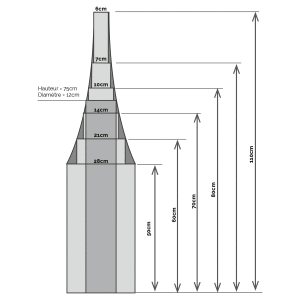LENGHT AND DIAMETER OF BOLLARDS, WHAT DO THE REGULATIONS SPECIFY?
To walk around in town, blind and visually impaired persons have to develop their own ways of perceiving the environment. They rely on their senses of hearing and touch and on mnemonics, which help them form a visual representation of their environment.
Implementing the law of 11 February 2005 on equal rights and opportunities, the participation and citizenship of persons with disabilities and its article 45, article 1 of decree 2006-1658 of 21 December 2006 states: “Street furniture, in particular bollards and posts, even when cantilevered, must be easily detectable by blind and visually impaired persons. ”
The ministerial order of 15 January 2007 clarifying the text among other things stipulates that street equipment and furniture placed on pedestrian paths should occupy a minimum volume. The obstacle detection chart in appendix 3 of the ministerial order, revised on 18 September 2012, prescribes the minimum dimensions of bollards and posts according to their height.
The dimensions of these items must comply with the above obstacle detection chart and show a contrast.
1) Dimensions
“The dimensions of bollards and posts are determined in accordance with the diagram opposite and take into account the following clarifications:
- the height is measured from the surface of the path;
- the overall width, the smallest of the dimensions, or the diameter are measured in the horizontal plane.
The height must be at least 50 cm. If the bollard or post is 50 cm high, its width or diameter must be at least 28 cm.
If the bollard or post is higher than 50 cm, the width or minimum diameter of its base is inversely proportional to its height.
For instance:
- the height of the post is 1.10 m at the very least for a diameter or width of 6 cm;
- a bollard with a width or diameter of 21 cm is at least 60 cm high”
2) Contraste
Contrast is useful for the visually impaired, helping them better perceive street furniture.
As a general rule, the item of street furniture should contrast strongly with its immediate surroundings.
Examples:
- A light-coloured bollard contrasts with a dark ground
- A dark bollard contrasts with a light-coloured building
If there is not enough contrast with the surroundings, the body of the bollard or post should contrast strongly with the top over a height of 100 mm in the most common cases.

